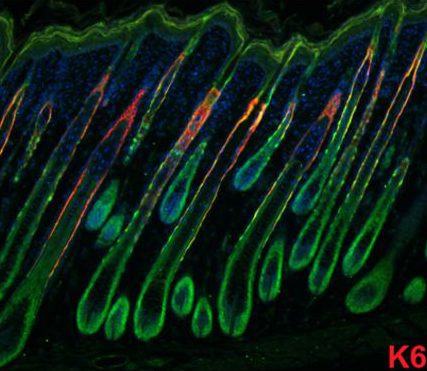The hair follicle as a system of stem cell biology
Posted by Erin M Campbell, on 11 April 2013
 Monday is tax day for most of us on the American side of the pond. That ought to cause massive hair loss for many folks, but we have amazing hair follicles that constantly regenerate hair throughout our adult lives (well, at least for those of us without male pattern baldness). A recent paper in Development helps us understand the hair follicle stem cells involved.
Monday is tax day for most of us on the American side of the pond. That ought to cause massive hair loss for many folks, but we have amazing hair follicles that constantly regenerate hair throughout our adult lives (well, at least for those of us without male pattern baldness). A recent paper in Development helps us understand the hair follicle stem cells involved.
Our hair follicles maintain hair growth throughout our adult lives, and go through different predictable phases of growth (anagen), regression (catagen), and rest (telogen). Each follicle is a little homeostatic system with adult stem cells that have the ability to self-renew and generate all of the cells required in the hair follicle. It is not completely understood how all of these mechanisms function together to achieve long-term homeostasis, but a recent paper helps identify the lineage progression of the different cell types in the follicle, and the relationships between them. Takeda and colleagues identified the marker Hopx in adult hair follicle stem cells. Lineage-tracing experiments showed that Hopx+ cells give rise to all cell types in the fair follicle. Takeda and colleagues also identified a novel population of Hopx+ cells in the lower hair bulb of follicles in anagen. Later in telogen, these newly-identified cells differentiate into the K6+ inner bulge layer in the stem cell niche, where they regulate the quiescence of nearby hair follicle stem cells. In the image above, Hopx (green) is found in several regions of a hair follicle in anagen. K6+cells (red) are the innermost cells surrounding the hair follicle shaft.
For a more general description of this image, see my imaging blog within EuroStemCell, the European stem cell portal.
![]() Takeda, N., Jain, R., LeBoeuf, M., Padmanabhan, A., Wang, Q., Li, L., Lu, M., Millar, S., & Epstein, J. (2013). Hopx expression defines a subset of multipotent hair follicle stem cells and a progenitor population primed to give rise to K6+ niche cells Development, 140 (8), 1655-1664 DOI: 10.1242/dev.093005
Takeda, N., Jain, R., LeBoeuf, M., Padmanabhan, A., Wang, Q., Li, L., Lu, M., Millar, S., & Epstein, J. (2013). Hopx expression defines a subset of multipotent hair follicle stem cells and a progenitor population primed to give rise to K6+ niche cells Development, 140 (8), 1655-1664 DOI: 10.1242/dev.093005


 (4 votes)
(4 votes)
Amazing article that was. Thanks!